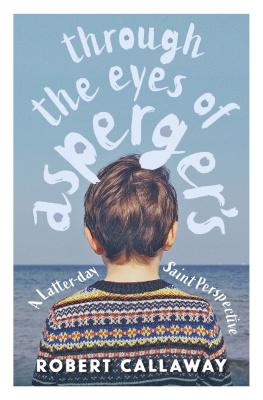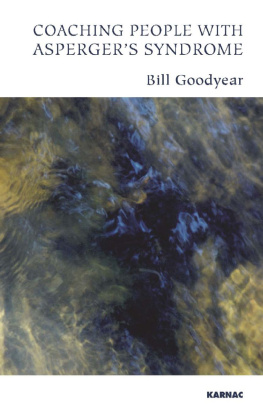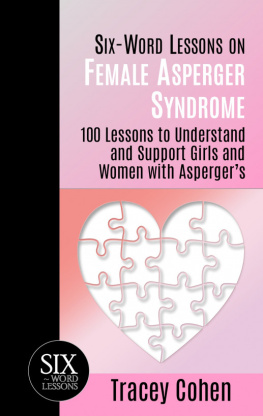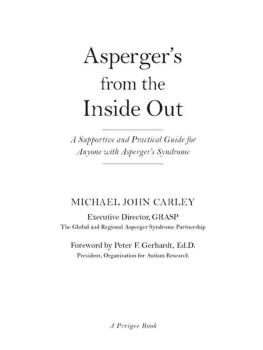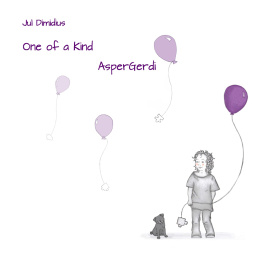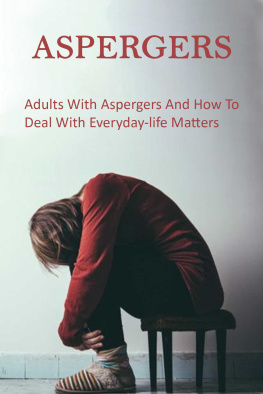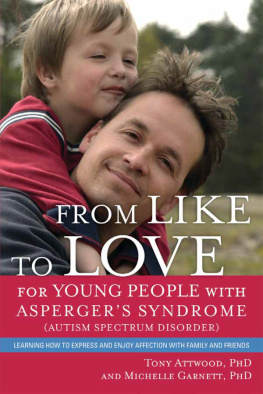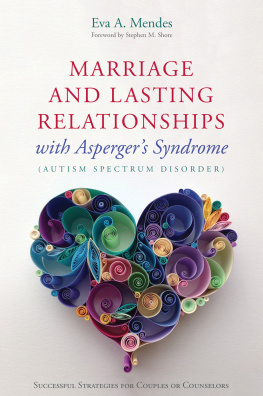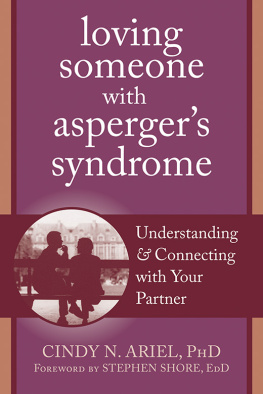Cindy N. Ariel gets it like few people do. With a vision that is steeped in both research and experience, she is able to guide us through the trials, confusion, and treasure of loving someone with Aspergers syndrome. She does this with open eyes and an open, compassionate heart. This is the kind of guide I wish for everyone who loves someone who is different.
Daniel Gottlieb, PhD, psychologist, family therapist, and author of Letters to Sam and The Wisdom of Sam
Discovering Aspergers syndrome is a true adventure. But intimate relationships can be complex. Partners most often must learn to reflect, adapt, and compromise for the relationship to succeed. Accepting each partners differences and reaching mutual understanding can be a long journey. In her book, Ariel truly captures the essence and uniqueness of an Aspergers-neurotypical relationship. With her explanations, examples, and exercises, she guides couples toward better communication, quality time, and intimacy. This book will inspire couples to attain a better relationship.
Isabelle Hnault, MA, PhD, sexologist, psychologist, and author of Aspergers Syndrome and Sexuality
Loving Someone with Aspergers Syndrome is a practical and helpful must-have guide for couples as well as therapists! This easy-to-read book includes lots of AS-friendly exercises based on the learning style of individuals with AS. These tools provide concrete activities that can assist couples in working through issues that commonly occur when one partner has Aspergers.
Diane Adreon, PhD, associate director of the University of Miami Center for Autism and coauthor of Asperger Syndrome and Adolescence
An informative and practical book that couples will enjoy reading to achieve greater mutual understanding and acquire strategies to enhance their relationship. This book will encourage realistic hope for the future and help partners rediscover and reinforce the deep love that can be felt for someone with Aspergers syndrome.
Tony Attwood, PhD, author of The Complete Guide to Aspergers Syndrome
Kudos to Cindy N. Ariel! While her new book, Loving Someone with Aspergers Syndrome, will be widely used by partners, its potential for use by professionals who are therapists and counselors is remarkable. The exercises help each of the two parties conceptualize what the other is thinking in a blameless, constructive manner so as to support change and adaptation. I fully plan to use this book in my university teaching programs for upcoming social workers.
Dena L. Gassner, LMSW, owner/director of the Center for Understanding in Nashville, TN, and contributing author to Scholars with Autism

Publishers Note
This publication is designed to provide accurate and authoritative information in regard to the subject matter covered. It is sold with the understanding that the publisher is not engaged in rendering psychological, financial, legal, or other professional services. If expert assistance or counseling is needed, the services of a competent professional should be sought.
Distributed in Canada by Raincoast Books
Copyright 2012 by Cindy N. Ariel
New Harbinger Publications, Inc.
5674 Shattuck Avenue
Oakland, CA 94609
www.newharbinger.com
Cover design by Amy Shoup; Text design by Tracy Marie Carlson; Acquired by Melissa Kirk; Edited by Nelda Street
All Rights Reserved
Library of Congress Cataloging-in-Publication Data
Ariel, Cindy N.
Loving someone with Aspergers syndrome : understanding and connecting with your partner / Cindy N. Ariel ; foreword by Stephen Shore.
p. cm.
Includes bibliographical references.
ISBN 978-1-60882-077-1 (pbk.) -- ISBN 978-1-60882-078-8 (pdf e-book) -- ISBN 978-1-60882-079-5 (epub)
1. Aspergers syndrome--Patients--Family relationships. 2. Spouses. I. Title.
RC553.A88A4878 2012
616.858832--dc23
2011039767
To my partner, Robert, and to the gifts of our relationship:
Kara and Zo
Contents
Foreword
Intimate relationships can be complex and require a lot of ongoing work, especially for someone with Aspergers syndrome (AS)as I, a person with AS, can certainly attest. I wish Cindy Ariels book had existed during the early days of my marriage, because this resource has given the autism community a valuable tool that can bring great insight to all who wish to learn more about what relationships are like for people who have AS.
From the beginning, Dr. Ariels accurate descriptions of Aspergers syndrome are extensive enough to replace such myths as the idea that people with AS are unemotional and unfeeling with the understanding that they are merely different and, therefore, are not a collection of deficits in need of remediation.
The initial pages draw readers to answer simple yet meaningful questions to help them gain greater insight concerning their partners on the autism spectrum. You will find pearls of wisdom throughout this book, as well as worksheets that lead to practical solutions for addressing issues and misunderstandings related to AS differences, such as perceived lack of empathy and possible resulting feelings of loneliness in the nonspectrum partner. The beauty of these worksheets is that they help non-AS partners get to the core of verbalizing how their AS partners different behaviors make them feel, how this affects the relationship, and how the two, often very different, viewpoints are really just alternate sides of the same proverbial coin. Additionally, the sample exercises quantitatively and qualitatively help guide partners, both on and off the autism spectrum, in formulating their responses.
Another unusual and welcome aspect of this book is that both relationship partners can use it, working together to mutually understand one another. For example, the reframing exercises, in which each partner describes a behavior that is challenging to the relationship, can be an excellent tool for considering the real reason why a partner might give a monologue on a subject of special interest or offer extremely restricted restaurant choices. Whereas most people outside the autism spectrum may consider food to be the most important aspect in selecting a restaurant, perhaps for people with AS, the most important factor may be avoidance of fluorescent lights, which appear to them to mimic strobe lights. Such reframing exercises, for example, would have been a great time-saver in helping my wife and me come to a mutual understanding about why some restaurants were just intolerable for me to eat at with her or anyone else.
Yet another of the many exercises explores the reasons why you may have fallen in love with your partner, by examining where initial attractions originate and whether these aspects are still working for you in your relationship. This process can provide valuable insights to all couples who may have drifted apart over time and wish to examine what brought them together in the first place.
Additional important aspects of relationships explored include identifying and ranking respective needs on a scale from 1 to 10 to determine relative importance, which is something everyone can understand, whether or not Aspergers syndrome is a factor. Most of all, this work masterfully enables couples to identify, verbalize, and communicate their wishes, desires, fears, and needs in a way that both partners can understand, process, and do something about. Although I wish that this resource had been available during the first two decades of my marriage, I feel fortunate to benefit from it now and feel that it will be very helpful to many readers.


